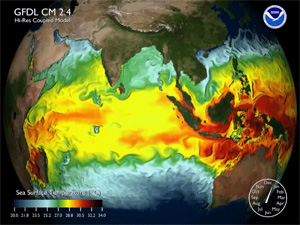High Resolution Climate Modeling

A vigorous effort is underway to build prototype high resolution coupled models for use in studying climate change, variability and predictions. In these coupled models, grid cells are substantially smaller than in our standard climate models, therefore significantly more of them are required to cover the globe and along with that, increased computationally resources are needed. However, the benefit is the potential for a more realistic simulation of the climate system, including its inherent variability and response to external forcings, such as increasing greenhouse gases. Using a variety of models with differing resolutions also provides an important test of the robustness of the model simulations.
For the 2007 IPCC report our "workhorse" climate model was CM2.1, with ocean resolution of approximately 100 Km and atmospheric resolution of approximately 200 Km. Building on that platform we are creating a series of prototype high resolution models with smaller grid cell sizes. The following describes the models currently being developed:
Nominal Model Resolution
| model | ocean(ice) | atmosphere(land) |
|---|---|---|
| CM2.4 | 0.25o | 1o |
| CM2.5 | 0.25o | 0.5o |
| CM2.6 | 0.1o | 0.5o |
In addition to finer resolution, the ocean components of these coupled models do not use a parameterization of mesoscale eddy mixing, have more accurate numerics, substantially smaller viscosity and virtually no explicit numerical diffusion. The result of these changes is an ocean flow that is much more energetic and realistic.
CM2.4 has been run for multiple century experiments using the computing facilities available at GFDL. The CM2.5 and CM2.6 models are too computationally expensive to run on our local computers, but are being developed to run on the larger facilities available at the Oak Ridge National Laboratory through a collaboration with the Department of Energy. Plans for these models include long control simulations and idealized climate change calculations. Additional simulations will examine aspects of decadal climate predictability. Results from these simulations will be made freely available through GFDL's data portal.

